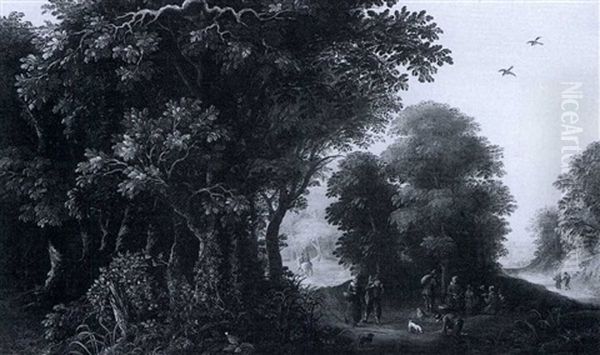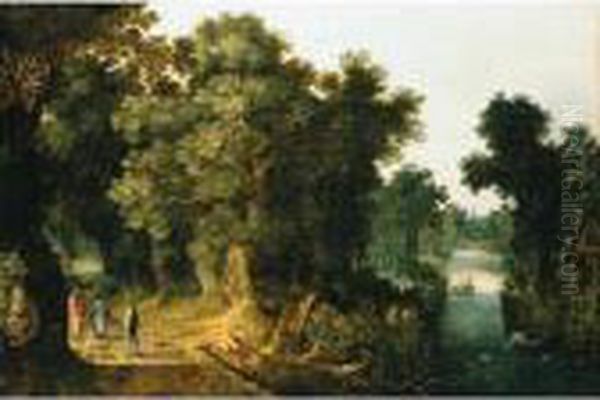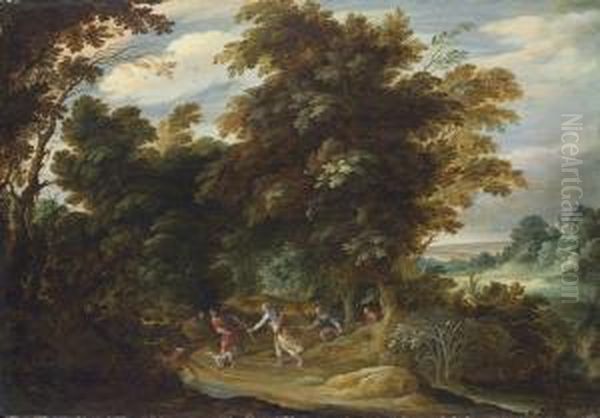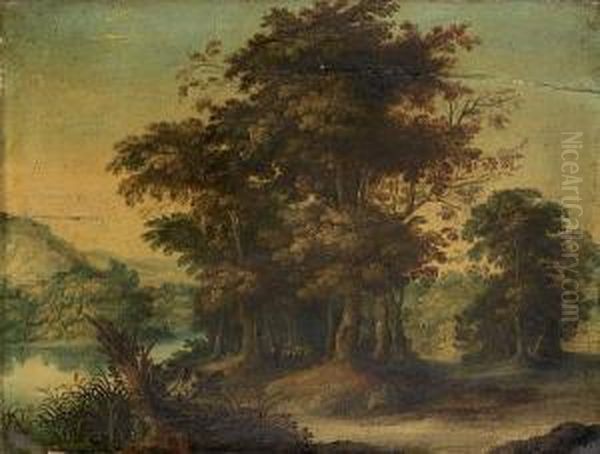Abraham Govaerts stands as a significant, albeit sometimes overlooked, figure within the rich tapestry of Flemish Baroque painting. Active during the vibrant artistic period of early 17th-century Antwerp, Govaerts carved a distinct niche for himself as a specialist in landscape painting, particularly renowned for his detailed and atmospheric depictions of forest scenes. His life, though relatively short, was marked by considerable artistic production, influential connections, and a lasting contribution to the development of landscape painting in the Low Countries.
Life and Career Beginnings
Born in Antwerp in 1589, Abraham Govaerts entered the world during a period of intense artistic activity in the city. Information regarding his earliest training is often linked to the towering figure of Jan Brueghel the Elder. While the exact nature of their relationship – whether formal apprenticeship or strong stylistic influence – remains debated by some scholars, the impact of Brueghel's detailed style and thematic choices is undeniable in Govaerts's work. Further shaping his artistic vision was the legacy of Gillis van Coninxloo, another pioneer of forest landscape painting whose work emphasized dense woodlands and dramatic light.
Govaerts formally entered the Antwerp artistic community by registering as a master in the prestigious Guild of Saint Luke between 1607 and 1608. This marked the official commencement of his independent career. Membership in the Guild was essential for artists wishing to sell their work, take on pupils, and participate fully in the city's thriving art market. From this point forward, Govaerts established himself as a dedicated painter of landscapes, quickly gaining recognition for his particular skill in rendering woodland interiors. His career unfolded primarily in Antwerp, the hub of Flemish art production.
Beyond his painting activities, records indicate Govaerts was also involved in other ventures. He is known to have purchased property in Antwerp, suggesting a degree of financial success. Furthermore, evidence suggests he engaged in the trade of second-hand clothing and possibly dealt in paintings, activities not uncommon for artists seeking supplementary income or investment opportunities during that era. He passed away relatively young, on September 9, 1626, at the age of 37, cutting short a productive career.
Artistic Style and Signature Techniques

Abraham Govaerts is best known for his cabinet paintings – small, finely executed works intended for intimate viewing – predominantly featuring forest landscapes. His style is deeply rooted in the Flemish tradition, yet possesses distinct characteristics. He often employed a compositional structure associated with Mannerism, sometimes referred to as the "three-color scheme" (Dreifarbigkeit), which involved using brownish tones for the foreground, greens for the middle ground, and blues for the distant background to create a sense of depth and atmospheric perspective.
A hallmark of Govaerts's work is the meticulous rendering of foliage. He depicted leaves and branches with remarkable detail and precision, often using bright, luminous greens that give his forests a vibrant, verdant quality. Unlike some contemporaries who might employ darker, more somber palettes, Govaerts favored clarity and brightness, skillfully using contrasts between light and shadow to model forms and enhance the illusion of depth within his woodland scenes. Sunlight often filters through the canopy, dappling the forest floor and highlighting specific elements within the composition.
His landscapes are typically structured with prominent trees framing the central view, drawing the viewer's eye into the scene. This framing device, common among landscape painters of his time, including his influences Jan Brueghel the Elder and Gillis van Coninxloo, served to create a contained, stage-like space within which narrative elements could unfold. The overall effect is one of controlled, carefully composed nature, rendered with exquisite detail and a sensitivity to light and color.
Themes and Collaboration
While primarily a landscape specialist, Govaerts frequently incorporated narrative elements into his forest settings. These scenes, often small in scale compared to the dominant landscape, typically depicted mythological, biblical, or occasionally historical subjects. Works like A Forest View with the Sacrifice of Isaac exemplify this approach, where the dramatic religious narrative is nestled within an intricately painted woodland environment. The trees and dense foliage serve not just as a backdrop, but as an integral part of the composition, encircling and emphasizing the central theme.
Collaboration was a common practice in the Antwerp art world, allowing specialists to combine their skills on a single artwork. Abraham Govaerts was a frequent collaborator throughout his career. He would typically paint the detailed landscape settings, leaving the figures, animals, or sometimes architectural elements to other artists who specialized in those areas. This practice allowed for a high degree of refinement in all aspects of the finished painting.

His most frequent collaborators included prominent artists such as Frans Francken the Younger, known for his skill in depicting small, lively figures. Many paintings exist where Govaerts provided the lush forest setting and Francken populated it with biblical or mythological characters. He also worked alongside Jan Brueghel II, the son of his influential predecessor, continuing the Brueghel workshop tradition. Their collaborations often involved Govaerts laying out the landscape while Brueghel might add details like flowers. Other documented or stylistically evident collaborators include landscape and architectural painters like Joos de Momper II, Tobias Verhaecht, Pieter Neeffs the Elder, Pieter Neeffs the Younger, and Hendrick van Steenwijk the Younger, each bringing their specific expertise to the joint creations.
Representative Works
Several key works illustrate Abraham Govaerts's style and thematic concerns. His painting titled Bois (often translated as 'The Woods' or referring to a specific work like 'The Great Oak Forest') showcases his mastery in capturing the textures and light of a dense forest. Such works emphasize his keen observation of nature and his ability to render complex arrangements of trees and undergrowth with clarity and detail.
A Forest View with the Sacrifice of Isaac is another significant example, demonstrating the integration of a dramatic biblical narrative within his characteristic woodland setting. The painting highlights his use of trees as framing devices and his skill in creating atmospheric depth through light and color, drawing the viewer towards the central figures while maintaining the prominence of the natural environment.
The painting known as Herberg (The Inn), a collaborative work with figures attributed to Frans Francken the Younger, is notable not only for its artistic merit but also for its attribution history. For a time, it was mistakenly attributed to another artist, Van Nieuwenhuyzen, highlighting the challenges that can arise in identifying works by Govaerts, particularly collaborative pieces or those lacking clear signatures. Its correct attribution underscores Govaerts's role in creating these complex, multi-artist compositions. These representative works collectively showcase his focus on detailed forest interiors, his integration of narrative elements, and his frequent participation in collaborative projects.
Workshop, Pupils, and Influence
As an established master in the Guild of Saint Luke, Abraham Govaerts was entitled to operate a workshop and train apprentices. Evidence confirms that he did take on pupils, contributing to the education and development of the next generation of Antwerp painters. Among his documented pupils are figures like Alexander Keirincx, who would go on to become a notable landscape painter in his own right, initially working in a style very close to Govaerts before developing his own distinct manner. Other recorded pupils include Nicolaes Aertsens, Hans Groenrijs, and Andries van den Bogaerde (or Vogenberga).

His workshop likely produced numerous paintings, catering to the strong market demand for cabinet-sized landscapes. The fact that Govaerts died relatively young meant that some works likely remained unfinished in his studio. It is known that after his death, prominent artists like Frans Francken the Younger, Jasper van der Lanen, Andries van Eertvelt, and Jan Brueghel II were commissioned to complete some of these unfinished pieces, further attesting to Govaerts's standing within the artistic community and the value placed on his work.
Govaerts's influence extended beyond his direct pupils. His detailed, brightly lit forest scenes contributed to a specific vein of landscape painting popular in the early 17th century. Artists like David Vinckboons, though working slightly earlier and in parallel, shared certain affinities in their approach to woodland subjects. The meticulous style Govaerts championed, derived from the Brueghel tradition, resonated with collectors and influenced contemporaries. Even later artists, such as the American painter Samuel F.B. Morse (though primarily known for inventing the telegraph), are noted in some sources as having been influenced by or having studied works in the tradition Govaerts represented, demonstrating the long-reaching, if sometimes indirect, legacy of this style.
Art Historical Assessment and Unresolved Questions
In art history, Abraham Govaerts is recognized as a highly skilled practitioner of Flemish Baroque landscape painting. His technical proficiency, particularly in the detailed rendering of foliage and the subtle handling of light and color, is widely acknowledged. Some assessments even suggest that his ability to blend colors harmoniously while maintaining their purity represented a refinement, or at least a distinct variation, compared to the work of Jan Brueghel the Elder. His bright palette and avoidance of heavy, dark tones gave his works a particular appeal.
However, his artistic reputation is not without nuance or critique. Some historians view his output as somewhat standardized, focusing consistently on the forest interior theme without the broader range of subjects tackled by artists like Jan Brueghel the Elder. This perceived lack of variety has led some to consider his contribution significant but perhaps less innovative than that of his most famous contemporaries. His adherence to a successful formula, while ensuring market appeal, might be seen as limiting his artistic exploration.

Furthermore, aspects of his career remain subjects of discussion. The precise division of labor in his collaborations, especially with figures like Jan Brueghel II, is not always definitively documented. Attribution issues persist, complicated by the collaborative nature of many works and the stylistic similarities between Govaerts and his close contemporaries and followers. The condition of some surviving works also presents challenges for study and appreciation. Despite these points of debate, Govaerts remains an important figure for understanding the specialization and collaborative practices that characterized the Antwerp art market and the specific evolution of the forest landscape genre in the early 17th century.
Conclusion
Abraham Govaerts occupies a specific and significant place within the history of Flemish art. As a master of the forest landscape, he built upon the traditions established by predecessors like Gillis van Coninxloo and Jan Brueghel the Elder, developing a distinct style characterized by meticulous detail, vibrant color, and atmospheric light. His specialization in cabinet paintings catered to the tastes of contemporary collectors, and his frequent collaborations with other leading Antwerp artists highlight the interconnected nature of artistic production during the Baroque period. Though his career was cut short, Govaerts left behind a substantial body of work that influenced his pupils, including Alexander Keirincx, and contributed significantly to the enduring popularity and development of landscape painting in the Southern Netherlands. He remains a key artist for appreciating the depth and specialization within the Antwerp school during its golden age.